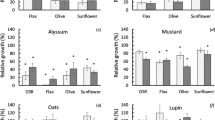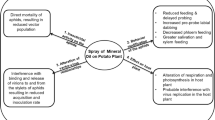Summary
Several herbicidal materials were screened as possible roguing agents on potato plants. Most of the materials were rejected because of their slow killing action and failure to prevent regrowth from seed pieces. In greenhouse and field trials, Diesel oil plus 0.4 per cent triethanolamine salt of 2, 4, 5-trichlorophenoxyacetic acid, Diesel oil plus 30 per cent of an Isopropyl N-(3-chlorophenyl) carbamate emulsion, and Diesel oil plus 1 per cent Dow General Weed Killer were found to be suitable for roguing purposes. In subsequent greenhouse trials, a mixture of Diesel oil and 10 per cent MH 30 killed sprayed plants and inhibited sprouting of seed pieces and harvested tubers. This indicates that further work should be be done on mixtures of Diesel oil and the newer growth-regulating compounds as chemical roguing agents.
Trials by seed potato growers have indicated that transporting roguers, roguing chemicals, and spray equipment with a tractor to locate and spray diseased plants is a quick, efficient roguing method. At present, however, the seed-pieces and tubers under sprayed plants must be dug and destroyed before harvesting. Further research may bring forth an ideal herbicidal mixture which would kill all of the seed pieces and tubers of sprayed plants and thus eliminate the need for digging them. The consensus of interviewed growers was that chemical roguing costs less and is more efficient than hand roguing.
The results of these chemical-roguing investigations show that efficient, inexpensive, roguing materials can be used to replace the tedious, costly, and inefficient hand-roguing methods in current use.
Similar content being viewed by others
Literature Cited
Barnard, E. E., and R. L. Warden. 1950. The effects of various herbicides on weed control, stands, and yields on Netted Gem potatoes. Res. Rept., 17th No Central Weed Control Conf. P. 145.
Denison, E. L. 1950. Maleic hydrazide on potatoes. Res. Rept., 7th. No. Central Weed Control Conf. P. 147.
Ellison, J. H., and Ora Smith. 1948. Effects of spraying a sprout inhibitor on potato plants in the field. Proc. Amer. Soc. Hort. Sci. 51: 397–400.
—. 1951. Retarding sprout growth of potato tubers by spraying the foliage with 2, 4, 5-trichlorophenoxyacetic acid. Proc. Amer. Soc. Hort. Sci. 54:447–451.
Ennis, W. B., Jr., C. B. Swanson, R. W. Allard, and F. T. Boyd. 1946. Effect of certain growth-regulating compounds on Irish potatoes. Bot Gaz 107: 568–574.
Hooker, W. J., and A. F. Sherf. 1951. Scab susceptibility and injury of potato tubers by 2, 4, 5-trichlorophenoxyacetates. Amer. Potato Jour. 28: 675–679.
Kennedy, E. J., and Ora Smith. 1951. Response of the potato to field application of maleic hydrazide. Amer. Potato Jour. 28: 701–712.
Kunkel, R., W. C. Edmundson, and A. M. Binkley. 1952. Results with potato vine killers in Colorado. Tech. Bull. 46. Color. Agr. Exp. Sta.
Otis, C. E. 1946. Killing potato tops with chemicals in Oregon. Ext. Circ. 484. Ore. Agr. Exp. Sta. 4 p.
Paterson, D. R., S. H. Wittwer, L. E. Weller, and H. M. Sell. 1952. The effect of preharvest foliar sprays of maleic hydrazide on sprout inhibition and storage quality of potatoes. P1. Physiol. 27: 135–142.
Rich, A. E. 1950. The effect of various defoliants on potato vines and tubers in Washington. Amer. Potato Jour. 27: 87–92.
Smith, Ora, M. A. Balza, and J. H. Ellison. 1947. Response of potato plants to spray applications of certain growth regulating substances. Bot. Gaz. 108:421–431.
Wittwer, S. H., and D. R. Paterson. 1951. Inhibition of sprouting and reduction of storage losses in onions, potatoes, sugar beets, and vegetable root crops by spraying plants in the field with maleic hydrazide. Mich. Agr. Exp. Sta. Quar. Bull. 34: 3–8.
Wood, D. C., and W. B. Ennis, Jr. 1949. Influence of butyl 2,4, 5-trichloro-phenoxyacetate upon the development of tuber abnormalities in Irish potatoes. Agron. Jour. 41: 304–308.
Young, P. A. 1931. Penetration and toxicities of petroleum-oil sprays. (Abs.) Phytopath. 21: 130.
—. 1935. Distribution and effect of petroleum oils and kerosenes in potato, cucumber, turnip, barley, and onion. Jour. Agr. Res. 51: 925–934.
Zukel, J. W. 1950. Use of maleic hydrazide as a plant growth inhibitor. Agr. Chem. 5: 35–36, 84.
Author information
Authors and Affiliations
Additional information
A portion of a thesis submitted to the Graduate School of Oregon State College in partial fulfillment of requirements for the degree of Doctor of Philosophy. This investivation was supported by a research grant from the Oregon Potato Commission. Tech. Paper No. 1162, Oreg. Agr. Exp. Sta., Corvallis, Oreg.
Rights and permissions
About this article
Cite this article
Barnes, G.L. Herbicidal agents as possible aids for roguing diseased seed-potato plants. American Potato Journal 36, 212–218 (1959). https://doi.org/10.1007/BF02852468
Accepted:
Issue Date:
DOI: https://doi.org/10.1007/BF02852468




